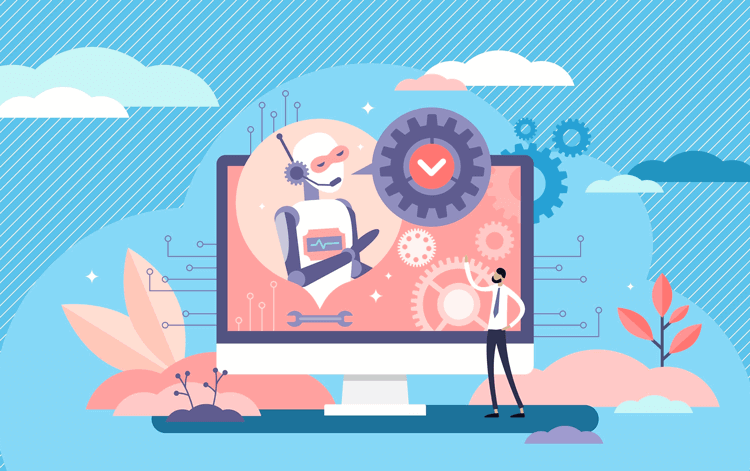The Complete Guide to Customer Service Knowledge Management
Customer Service Knowledge Management is essential to the smooth operation of any customer service, Customer Experience (CX), sales and account management teams.

Without an up-to-date and easily searchable knowledge management system, it's impossible for front-line agents to quickly and effectively answer customer service queries.
In this article, we're giving you a guide to Customer Service Knowledge Management, including, what it is and why companies should invest in it.
What is Customer Service Knowledge Management?
Customer Service Knowledge Management is an internal repository or digital library of everything that customer service agents need to know when handling customer queries. It is usually in the form of a software platform (SaaS).
According to McKinsey, having a Customer Service Knowledge Management system can reduce an agent's search time for answers by an estimated 35%. When agents are empowered and able to find answers to customer questions quickly and easily, customers are happier.
In our hyper-connected age, customers value faster responses. A fast response is when a telephony or Live Chat agent can answer a question and resolve an issue within a matter of minutes. Assuming it's a fairly easy query to answer and not one available on a self-help or self-serve portal.
According to HubSpot, 82% of customers or potential customers want a sales or marketing question answered right away. This means an organization is adhering to First Call Resolution (FCR) Key Performance Indicators (KPIs). When it comes to a support query, 90% of customers want and expect an immediate response within FCR and Average Handling Time (AHT) Service Level Agreements (SLAs).
A Customer Service Knowledge Management system or a search-friendly database is the answer.
Benefits of Implementing a Knowledge Management System for Customer Service
Implementing a knowledge management system for customer service teams generates operational value in numerous ways:
- Improved efficiency for customer service agents: They can find answers quicker, so they can handle more inbound calls or Live Chat conversations
- Increased customer satisfaction: Faster responses ensure customers are happier, reducing churn and increasing revenues
- Faster response times: This means agents are better at adhering to KPIs and SLAs, making customer service teams more cost-effective
- Technology-driven service improvements: With Artificial Intelligence (AI)-based tools embedded in Customer Service Knowledge Management systems, agents can save even more time in finding the information they need to serve customers more effectively and resolve problems
Different Types of Knowledge in Customer Service
Customer service agents need access to a wide range of information to help customers with their queries.
A knowledge management system should give agents access to everything customers can find through self-serve portals, alongside an extensive suite of internal knowledge resources that answer questions a company can't publish externally.
Knowledge management systems should include resources on the following:
- Product or service information: everything on how a product or service works
- Troubleshooting: every available resource on what can go wrong and how to fix something (e.g., product repair or return processes, self-help troubleshooting guides, etc.)
- Company policies and procedures: for example, "What's our policy when X happens?", and "How do we fix Y for a customer?" Such as, "What can we do if a customer's product breaks and is outside of the warranty?"
- Customer data and how to access it, including the processes and systems to verify a customer over various channels; e.g., telephony, email, Live Chat, social media, etc.
Having everything in one place and accessible to everyone from the customer service manager down to every front-line agent is essential.
How to Create a Knowledge Management System for Customer Service
In most cases, the resources for a Customer Service Knowledge Management system come from a number of sources:
- Training documents and manuals
- Internal policies and procedures
- Information about the products and services the company sells
- Troubleshooting documentation, frequently asked questions (FAQs), and other related resources
Alongside that, a knowledge management system should be constantly updated. This includes if anything changes, or if customers have new problems they've encountered. Make it a policy to identify sources of knowledge and organize it in a user-friendly way.
How to Train Customer Service Agents on Using the Knowledge Management System Effectively
Customer service agents need to know where to find the knowledge management system and how to use it.
Training for using a knowledge management system should be an integral part of training every new agent. As a web-based platform, portal, or app, it needs to be on every agent's desktop or browser. It should be one of the systems every agent logs in to at the start of their shift and should be open and accessible for every call.
A knowledge management system should have an easy and effective search function. This can be made even easier to use with an AI-powered assistant.
Making use of the knowledge management system should be an integral KPI for every customer service agent. Otherwise, agents will spend too long searching for answers or asking for help. It should be the go-to resource as a single source of truth for an organization.
Role of Technology in Customer Service Knowledge Management
Technology plays a vital role in knowledge management systems. For example, the increasing use of chatbots and AI to provide quick and accurate responses to customers.
Giva's SaaS-based Customer Service Software and Knowledge Management software are all examples of the tools organizations use to make it easier for front-line agents to interact with and support customers.
In most organizations, you need software that manages customer queries across multiple channels, such as telephony, Live Chat, email, and social media.
Integrated with that software, you need AI tools that support agents and the organization more effectively. Behind the scenes, you need Knowledge Management software that provides a real-time, updated repository of operational information, training, and resources for agents.
Most organizations also have customer-facing self-serve tools and portals with AI chatbots that provide additional support to customers.
Examples of Successful Customer Service Knowledge Management Systems
Knowledge management systems are usually internal resources. On the flipside, the majority of mid-size and large organizations also have external, customer-facing knowledge base or self-help resources.
Some great examples of this include Amazon, which has a "well-established knowledge management system that caters to both its employees and customers. This system, which dates back to the 1990s, is well-known for its ease of use and comprehensive information."
Another example: "Instacart's knowledge management system has a very simple mechanism that works for anyone, whether they are tech-savvy or not."
We have also reviewed knowledge management platforms that organizations publish for customers, also known as self-serve portals.
For example: "The University of New South Wales (UNSW) has a nice and simple IT Service Catalog portal. It comes complete with an AI bot and ways for students and academics to contact the IT help desk team."
Another example: "At the University of Arizona, there is a simple and easy-to-navigate IT help desk catalog. In particular, the U of A IT department has made certain services more prominent, such as reporting a problem (via a ticket or calling the team), requesting services, reporting security breaches, and access to self-serve tools."
Learn more: Take a look at our article on 10 excellent IT service catalog examples.
How to Keep Improving a Customer Service Knowledge Management System
An internal knowledge management system, and the knowledge base it contains lose value if not updated regularly. Any number of factors could require the content it contains to be updated:
- New products or services
- New regulatory changes (such as in telecoms, healthcare, or financial services)
- A product that is faulty or needs a recall
- New operational policies or procedures
When changes come down internally, management should be responsible for making sure the knowledge management system is updated. They should also ensure front-line agents are aware of the changes and training is provided.
However, there are times when knowledge management updates come from customers. For example, a company launches a new product. Customers buy it enthusiastically but there are problems, such as issues that cause customers to contact customer support, and these calls and messages are coming in every day.
In this situation, front-line agents need to log the calls and messages. They then either submit the information for knowledge approval, or make managers aware of the issues so the knowledge management system can be updated.
Keeping a knowledge management system continuously updated can be done in the following ways:
- Manually: As outlined above, implement a system so that agents can flag and record conversations so they go through to quality assurance (QA) team members or managers. Then, the relevant information can be input into the knowledge management system.
- With AI assistance: Many modern knowledge management systems have AI tools built-in. You can create settings to flag and record conversations about new topics so they automatically go through to the right team members to be turned into new knowledge management articles. The same approach will also let you turn these into self-serve articles, FAQs, and other pieces of content as required.
Ongoing ROI of Customer Service Knowledge Management
Having an effective, frequently updated, and easily searchable knowledge management system can have a massive positive impact on overall business success, such as increased customer loyalty and retention.
When customer service agents can do their jobs more effectively they are better equipped to support and retain customers. When customers stay loyal, and get answers to their questions quickly, that keeps churn low and makes it easier for businesses to keep growing.
It's an operational necessity that has a significant impact on any organization's top and bottom line.
Key Takeaways: The Importance of Customer Service Knowledge Management
In today's competitive business landscape, having a clear and effective, constantly updated knowledge management system can help companies provide exceptional customer experiences.
Front-line agents need to be able to access all of the information they require to do their jobs effectively. Competent, knowledgeable agents make a huge positive difference to the customer experience. In turn, happy customers, even ones who were unhappy about something that an agent was able to resolve, stay loyal.
Having a knowledge management system is an essential component of every customer service operation, and something worth investing in from a top and bottom-line perspective.
Is It Time Your Business Experienced the Giva Difference?
Giva has a suite of SaaS tools for customer service and call center teams and outsourcing companies, including:
Simple clean design. Cultivate and leverage in-house experience through shared knowledge. Giva inspires a movement of contribution where wisdom is captured and leveraged.
- Deploy in days, train in 1 hour
- Robust, fast and painless reporting for higher-quality decision-making
- Highly customizable without programming or consultants



